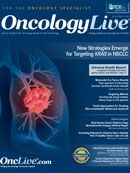Making the Molecular Leap
Our coverage of the 15th Annual International Lung Cancer Congress, which Physicians' Education Resource (PER) hosted July 31-August 2 in California, illustrates how nuanced genomic targeting has become in NSCLC.
OncLive Chairman,
Mike Hennessy
It was just three years ago that researchers presented the first detailed molecular profile of lung adenocarcinomas at the 2011 American Society of Clinical Oncology Annual Meeting. The Lung Cancer Mutation Consortium, which 14 of the nation’s leading cancer centers formed with the help of federal funding, identified driver mutations in this type of non—small cell lung cancer (NSCLC) after analyzing tumor specimens from 1000 patients.
At the time, the research and the process that produced it were groundbreaking. Today, the understanding of the molecular underpinnings of lung cancer has moved far beyond the consortium’s initial work, and the breadth of those advances is captured on OncLive. Our coverage of the 15th Annual International Lung Cancer Congress, which Physicians’ Education Resource (PER) hosted July 31-August 2 in California, illustrates how nuanced genomic targeting has become in NSCLC.
The exploration of KRAS mutations in NSCLC, for instance, has evolved into mutation subtypes distinguishable by the patient’s smoking status. Similarly, the concept of combining tyrosine kinase inhibitors (TKIs) for the treatment of patients with NSCLC would have been a short discussion when the consortium began its work, but since then three more TKIs have gained the FDA’s approval.
Finally, the recently launched Lung-MAP trial aims to channel patients with squamous cell carcinomas into novel targeted therapies based on the mutational status of their tumors. If successful, the trial could deliver the first targeted therapies for individuals with this NSCLC subtype.
These changes in clinical approaches to the treatment of individuals with lung cancer reflect the broader revolution that continues to shake the field of oncology practice today.
In his column, Editor-in-Chief Maurie Markman, MD, discusses the challenges that clinicians face as they seek to assimilate and leverage the bounty of molecular data coming their way. One approach is to retool the tumor board concept by bringing experts in genomic profiling into the mix when discussing how best to manage a particular patient.
It is our goal to keep practicing oncologists up to date on these rapidly shifting developments in cancer care. Please let us know how you are coping with these changes and what you would like to see presented.
As always, thank you for reading.




